This Cilantro Coconut Chutney combines peppery cilantro, sweet coconut, spicy serrano chili and a unique finishing touch of tempered spices for a vibrant side dish in both color and flavor. This super simple south-Indian condiment is easy to make in 15 minutes and pairs well with idli, dosa and uttapam.
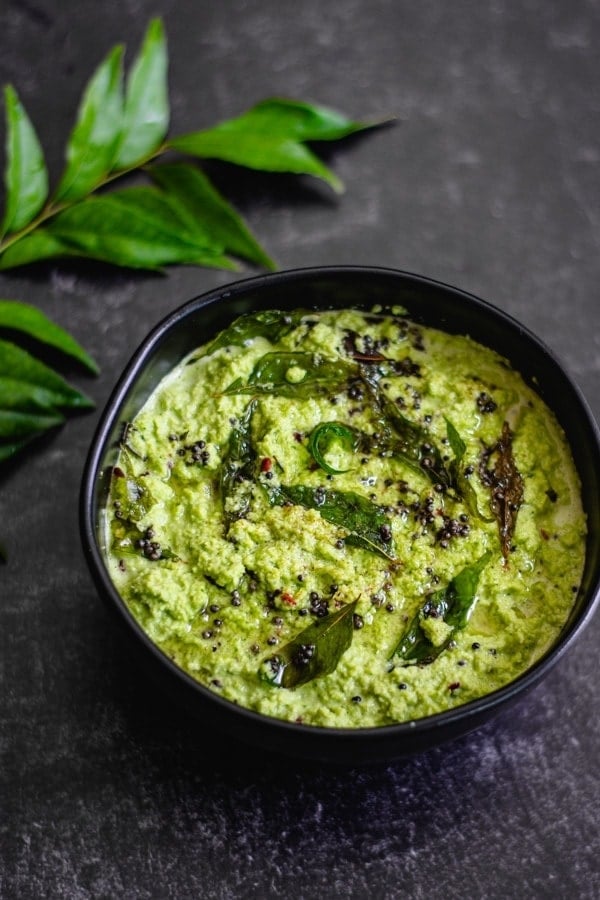
Want to save this recipe?
Vegan & Gluten-Free Condiment
Cilantro Coconut Chutney is a vibrantly green condiment made primarily of fresh cilantro and coconut that's delicately finished with tadka (tempered Indian spices).
The cilantro adds that special touch of fresh flavor and color. But an even bigger part of the chutney is the tempering. Fried mustard seeds, golden urad dal and crispy curry leaves add more flavor and textural appeal.
It's also Gluten-Free, Vegetarian and Vegan (since the tadka is made with plant-based oil)!
I often serve it the traditional south-Indian way, with idli, dosa, uttapam or vada, along with sambar (lentil and vegetable stew).
Quick & Easy Coriander Coconut Chutney Recipe
A traditional meal in India wouldn't be complete without a bowl of chutney alongside. They are meant for cooling, vibrancy, tang and acidity.
This Cilantro or Coriander Coconut Chutney Recipe (coriander is the alternative name for cilantro) takes the naturally sweet flavor of coconut to new heights. It is very similar to regular coconut chutney which is made with pretty much the same ingredients except cilantro, and is creamy-white in color.
This chutney recipe is one of my favorite side dishes to pair with south-Indian dishes. Here's why:
- It requires simple pantry and freezer ingredients
- Easy to make in only 15 minutes
- Makes a wonderful pair with idli, dosa, uttapam or vada
- Tastes better when made-ahead
- Keeps for up to one week in the fridge (and can even be frozen!)
Coconut Health Benefits
The star ingredient in this chutney is coconut. Even though coconut is rich in calories and fat, this palm fruit packs in so much nutritional value, the higher calorie content is completely worth it.
Coconuts add flavor, variety and health benefits to your diet, including:
- Rich amounts of lauric acid, which is known for being antiviral, antibacterial and antifungal, and boosts the immune system
- Increased metabolism that promotes a healthy thyroid function
- A boost in your daily energy
- Rejuvenation to your skin that helps to prevent wrinkles (I'm counting on this)
Ingredients - Notes & Substitutions
The main ingredients you need to make cilantro chutney include cilantro and coconut, along with a few aromatics and water.
- Cilantro: Use freshly purchased cilantro to prepare the chutney. The leaves and soft green stems can be used, but I recommend cutting off the bottom 2-inches since that part of the herb can be bitter.
- Coconut: I love to use freshly grated coconut every chance I get. Rather than having to take apart a whole coconut on my own, I look for freshly grated coconut in the prepared produce section of my grocery store. Alternatively, frozen grated coconut can be used for ease and convenience. Look for it in Indian grocery stores.
- Tadka (Tempering): The finishing tadka includes a touch of plant-based oil (coconut, avocado or light olive oil), asafoetida (heeng), black mustard seeds, split urad dal and curry leaves. If you don't already have these ingredients on hand, all are easily available at Indian markets or online.
Step-By-Step Instructions
Now, all you need is a blender and 15 minutes for freshly prepared cilantro coconut chutney! Simply:
1. Blend Chutney Ingredients
- In the following order, add cilantro, green chili, ginger, grated coconut and salt in the blender. Start by adding ½ cup water and blend. (if using Blendtec, hit the smoothie button).
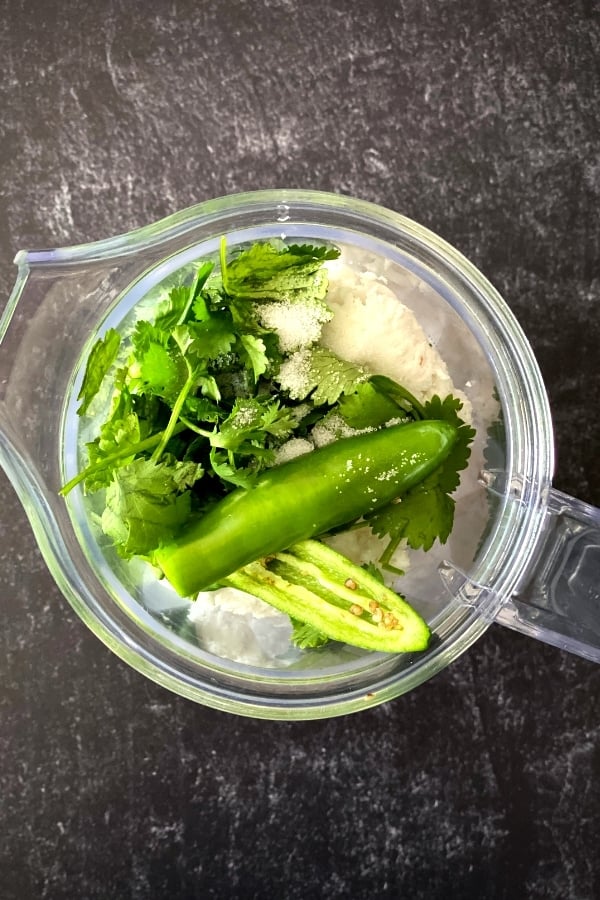
- Add more water as needed through the pourer while blending, until it blends to a smooth texture. Transfer to a serving bowl.
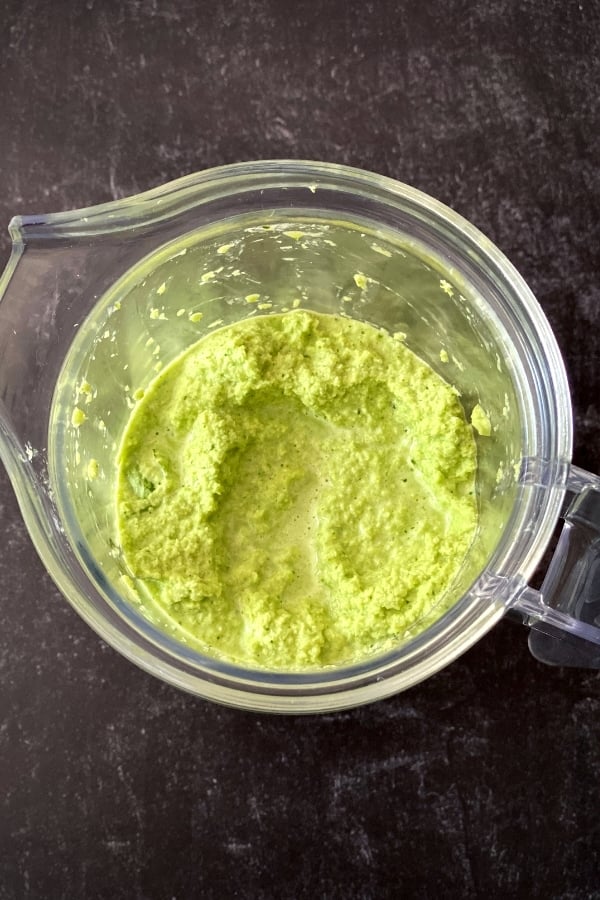
2. Prepare Tadka (Tempering)
- Heat a small fry-pan on medium heat. When hot add oil, heeng, mustard seeds and urad dal.
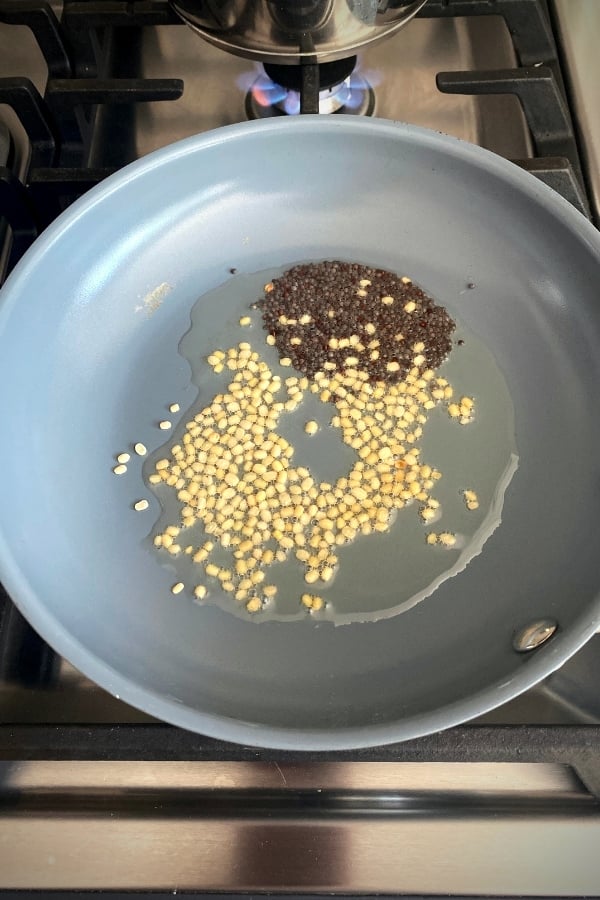
- Stir and cook until the urad dal turns golden brown and mustard seeds pop. Stir in curry leaves and turn off the heat.
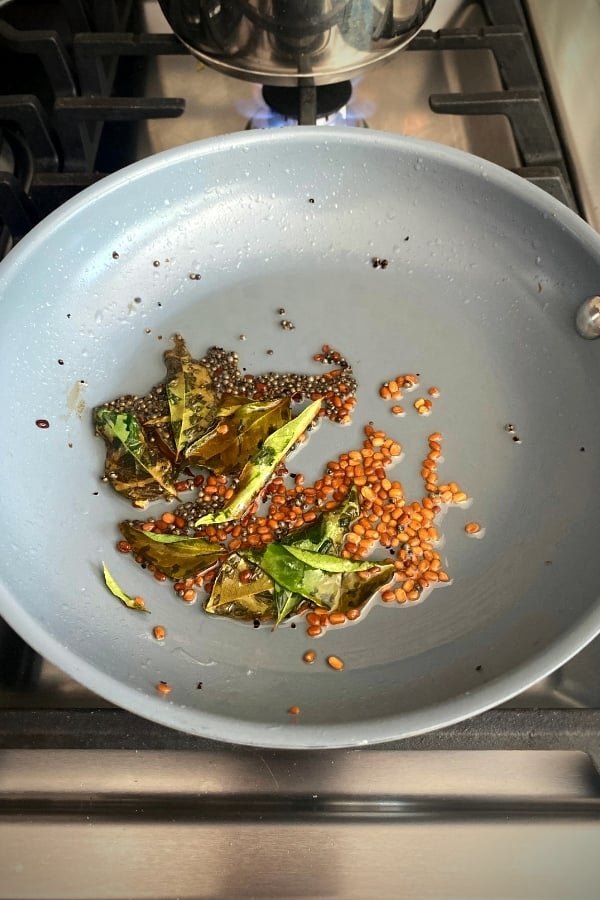
3. Add Tadka to Chutney
- Pour the tempering over the chutney and mix. Serve at room temperature or cold, with your favorite south-Indian entree, like idli, dosa or uttapam.
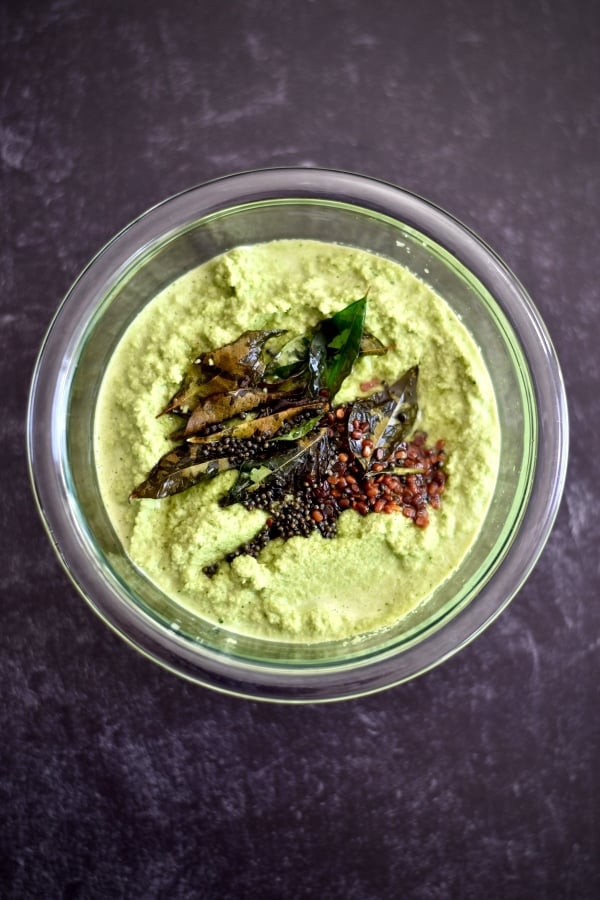
Make-Ahead & Servings Suggestions
I recommend allowing the chutney to sit for at least 30 minutes (and up to a few hours) in the refrigerator for the flavors to come together. This makes it a wonderful make-ahead recipe.
Plus, the chutney tastes much better when served cold.
If you'd like to follow tradition, serve cilantro chutney with Idli and sambar. In India, these three pairings are considered one of the healthiest breakfasts to power you through your morning.
If you're looking for a quick lunch or a flavor-packed snack, coconut chutney goes particularly well with dosa (cripy crepes) and uttapam (savory pancakes), too!
Storage Instructions
To store, refrigerate the chutney in an airtight container for up to one week.
For longer storage, it can also be frozen in a freezer-safe airtight container for up to 3 weeks. Simply thaw overnight in the fridge before serving.
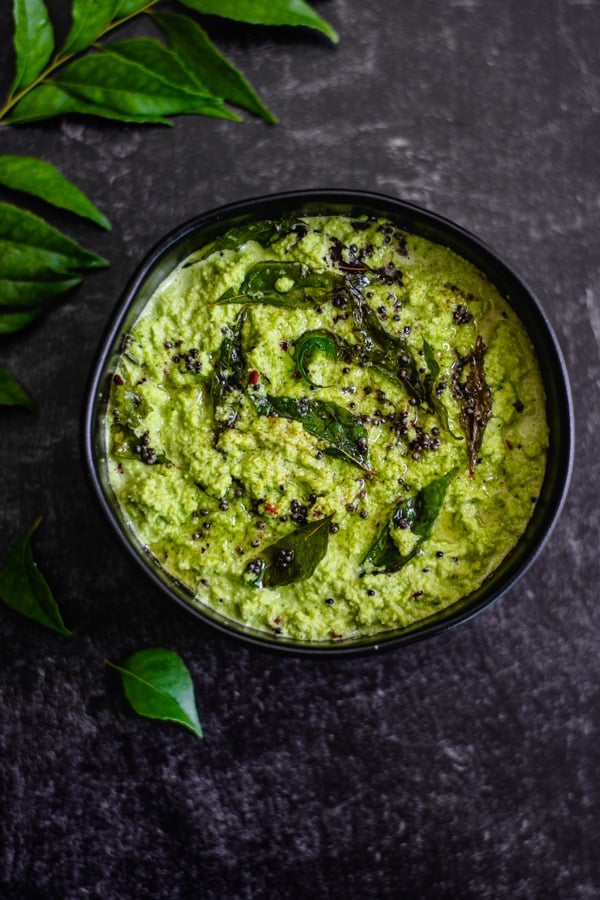
Variations To Try - Different Types of Coconut Chutney
There are many variations you can try to make this coconut chutney your own. A few suggestions include:
- Mint: Replace half the cilantro with mint leaves (stems removed)
- Peanut: Add ½ cup unsalted peanuts (roasted, shelled and skins removed) for a creamier consistency
- Tamarind: Add 1 teaspoon tamarind concentrate (tamarind paste) for a slightly sour tang
- Lime/Lemon Juice: Add 1-2 teaspoons fresh citrus juice for another layer of flavor
- Chana Dal: Add 1 teaspoon chana dal (split chickpeas) to the tadka
Recipe Tips & Notes
- Trim off the bottom 2-inches of the cilantro stem. The bottom portion of the stems has a woody taste and is not very palatable. Add the remaining leaves and light green stems to the blender.
- For a mild flavor, remove the seeds and stems from the chili pepper. Alternatively, remove only half for medium or keep them all intact for spicy.
- For best results, use freshly grated coconut. Look for it in the prepped produce section of most grocery stores. If fresh is unavailable, my next preference is frozen grated coconut. Thaw it in the refrigerator for a few hours or overnight before using.
- Add the ingredients in the order listed in the recipe. This creates a better emulsion and makes it easier on the blade of your blender.
- Start with ½ cup water and add more as needed. Add water, 1 Tablespoon at a time, through the pourer while blending, until it blends to your desired consistency.
- For a little tang, feel free to add a few teaspoons fresh lime/lemon juice. Add as much or as little as needed.
- Serve cold. Allow to sit in the fridge for at least 30 minutes and serve alongside sambar, Idli, dosa, uttapam and vada.
- Refrigerate the chutney in an airtight container for up to one week. Or freeze for up to 3 weeks and thaw overnight in the fridge.
Cilantro Coconut Chutney FAQs
Cilantro coconut chutney is slightly sweet and spicy thanks to the combination of fresh coconut and chiles. The addition of tadka at the end takes this side dish to another level.
My preferred method is the blender, but feel free to use a food processor if that is all you have on hand. Simply follow the directions in the recipe card and pulse to a smooth consistency.
More Indian Chutney Recipes Like This
- Peach Chutney: Sweet juicy peaches cooked with fresh ginger and seasoned with a hint of roasted cumin and cayenne prepared in the Instant Pot
- Green Chutney: Mildly spiced dipping sauce made with fresh cilantro, green chiles, ginger, lime juice and a touch of honey
📖 Recipe
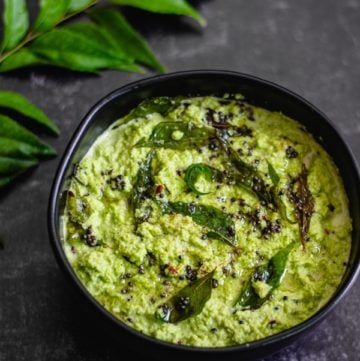
Cilantro Coconut Chutney (Nariyal Chutney)
Want to save this recipe?
Equipment
Ingredients
Chutney Ingredients
Tadka (Tempering)
- 1 tablespoon oil (coconut/avocado/light olive oil)
- 1 pinch asafoetida (heeng)
- ½ teaspoon mustard seeds (black variety)
- 1 teaspoon split urad dal (urad dhuli)
- 7-8 curry leaves
Instructions
Blend Chutney Ingredients
- In the following order, add cilantro, green chili, ginger, grated coconut and salt in the blender. Start by adding ½ cup water and blend. (if using Blendtec, hit the smoothie button).
- Add more water as needed through the pourer while blending, until it blends to a smooth texture. Transfer to a serving bowl.
Prepare Tadka (Tempering)
- Heat a small fry-pan on medium heat. When hot, add oil, heeng, mustard seeds and urad dal. Stir and cook until the urad dal turns golden brown and mustard seeds pop. Stir in curry leaves and turn off the heat.
Add Tadka to Chutney
- Pour the tempering over the chutney and mix. Serve at room temperature or cold, with your favorite south-Indian entree, like idli, dosa or uttapam.
Notes
- Trim off the bottom 2-inches of the cilantro stem. The bottom portion of the stems has a woody taste and is not very palatable. Add the remaining leaves and light green stems to the blender.
- For a mild flavor, remove the seeds and stems from the chili pepper. Alternatively, remove only half for medium or keep them all intact for spicy.
- For best results, use freshly grated coconut. Look for it in the prepped produce section of most grocery stores. If fresh is unavailable, my next preference is frozen grated coconut. Thaw it in the refrigerator for a few hours or overnight before using.
- Add the ingredients in the order listed in the recipe. This creates a better emulsion and makes it easier on the blade of your blender.
- Start with ½ cup water and add more as needed. Add water, 1 Tablespoon at a time, through the pourer while blending, until it blends to your desired consistency.
- For a little tang, feel free to add a few teaspoons fresh lime/lemon juice. Add as much or as little as needed.
- Serve cold. Allow to sit in the fridge for at least 30 minutes and serve alongside sambar, idli, dosa, uttapam and vada.
- Refrigerate the chutney in an airtight container for up to one week. Or freeze for up to 3 weeks and thaw overnight in the fridge.

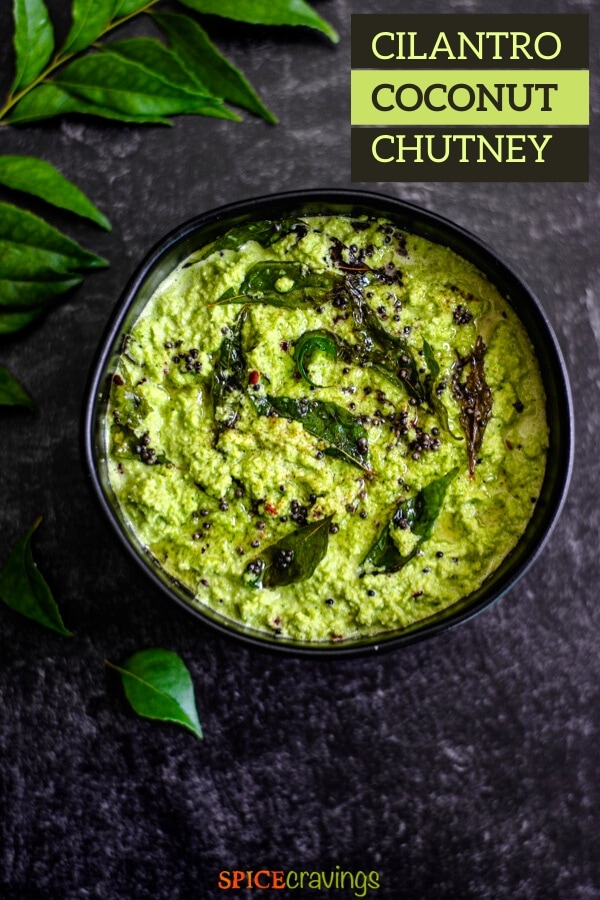
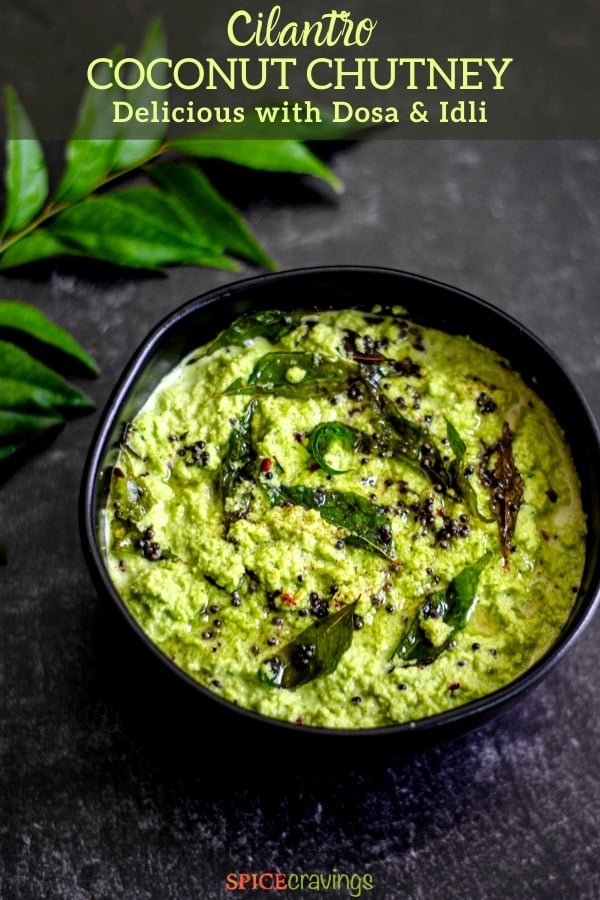
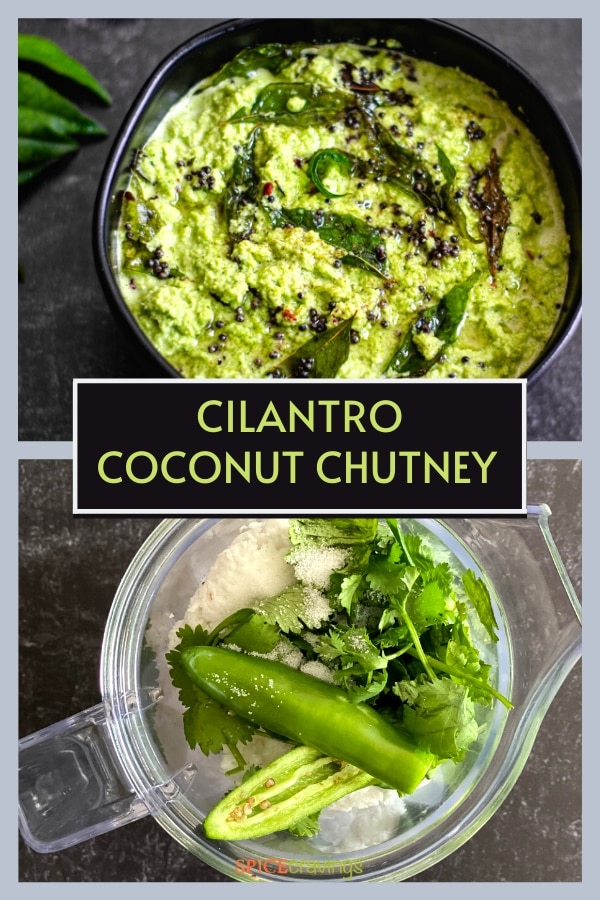
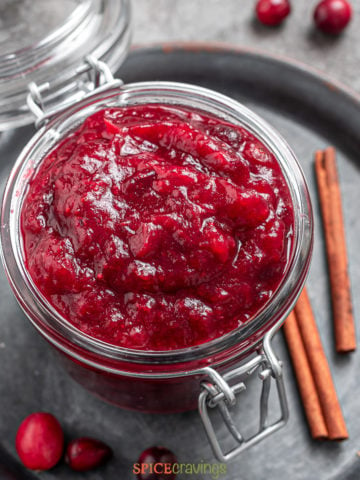

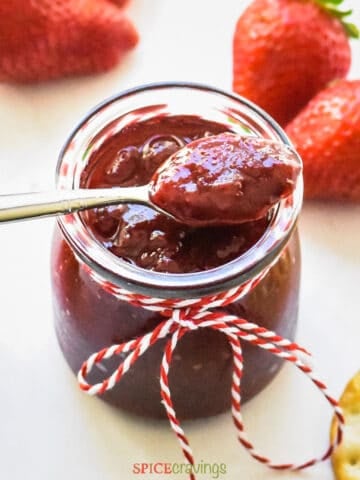
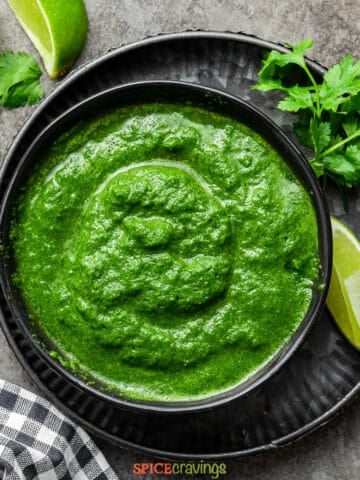
Leave a Reply